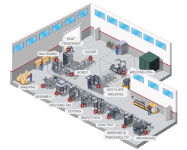Robotic cells are highly advanced systems programmed to carry out a specific task or multiple tasks. They are commonly integrated into various manufacturing operations to boost efficiency, enhance product quality, and improve employee safety via automation. Here, we’ll explore robotic cells and their role in manufacturing electronics and auto parts. For more information on this topic, please download our eBook.
What Is a Robotic Cell?
A robotic manufacturing cell is an automated work system consisting of one or several programmable robots. Sometimes called robot cells or robotized cells, these systems are used to perform specific functions at various points in the manufacturing process.
Typically, robotic cells are composed of the following primary components:
- A robot
- Vision systems
- Auxiliary tools
- Safety barriers
Depending on your unique needs, system integrators can design the most effective robot cell that enhances safety and makes the most of available space. By integrating these systems into your electronics and auto part manufacturing processes, you can optimize and speed up operations.
Robotic Cells in Electronics Manufacturing
The electronics manufacturing industry is a rapidly advancing sector that relies on the latest production technologies to meet demands for faster, smaller, and more sophisticated devices. Robotic cells are ideal for helping manufacturers meet these demands, offering benefits such as:
- Ease of Integration. Modern robotics systems are easy to program, integrate, and deploy. Robotic cells can meet the unique needs of the electronics industry – for example, they can be designed with secondary decoders to achieve the required precision and accuracy.
- Improved Reliability. Robots offer incredible reliability, with many offering a mean time between failure (MTBF) of over 62,000 hours. Although robotic cells may include several sensors, machines, and other devices that have higher error rates than the actual robot itself, the overall system is typically far less complicated than other automation solutions.
Robotic Cells in Auto Parts Manufacturing Operations
Robotic cells are ideal for carrying out various tasks in the auto parts manufacturing industry, including:
- Welding. Robots with extended reach and high payload can manipulate and weld large components like frames and body panels. Small robots with shorter arms can weld brackets, handle mounts, and other subassemblies.
- Assembly. A robotic assembly cell can perform complex and laborious processes, such as motor and pump construction, windshield installation, wheel mounting, and screw driving.
- Machine Tending. Robotic systems can be programmed to perform machine tending tasks, including loading components into CNC machines and removing finishing moldings from injection molding equipment.
- Material Removal. Programmable robots can perform various repetitive material removal tasks, such as flash trimming, mold polishing, and fabric cutting.
- Part Transfer. Robotic cells can perform labor-intensive and unsafe tasks, including moving heavy or hot components throughout a manufacturing facility.
Download Our eBook on Robotic Cells for Manufacturing Electronics & Auto Parts
Robotic cells offer several advantages for electronics and auto part manufacturing, including improved worker safety, enhanced productivity, and better product quality. At AMD, our highly experienced team of robotics experts can design custom robotic cells capable of handling both simple and complex manufacturing tasks.
For more information about the many benefits, features, and applications of robotic cells within electronics and auto part manufacturing operations, download our eBook. You can also request a quote to get started on your custom robotic cell solution.

